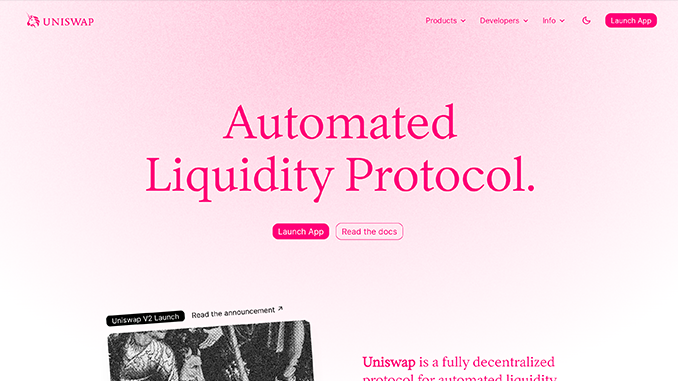
Uniswap is a decentralized crypto exchange for Ethereum and ERC-20 tokens with a special goal: Uniswap is intended to solve the problem of lack of liquidity by storing ERC-20 tokens paired with ETH in a pool and automatically forming prices.
Normally, prices on exchanges are formed by matching supply and demand, with the exchange itself organizing and processing the deals that come about. This principle also applies to the large crypto exchanges. With decentralized crypto exchanges (DEX), on the other hand, there is no central instance; buyers and sellers conclude their transactions directly with each other. This eliminates fees and does not require any identity checks (KYC). But DEXs often lack liquidity; especially smaller crypto currencies often do not reach the status where there are enough buyers and sellers facing each other. Uniswap wants to solve this problem, at least for ERC20 tokens, thus all crypto currencies, which are based technologically on the block chain of Ethereum (ETH).
The concept of Uniswap
Uniswap reached version 2.0 in May. Uniswap collects liquidity in ETH and ERC-20 tokens. This pool is used to secure barter transactions between Ethereum and ERC-20 tokens or the exchange of ERC-20 tokens among themselves. The simple portal for this can be found here. It allows to connect external wallets with Uniswap, including the widely used Trust Wallet. Price information is available on a second website here and in real time here.
The real highlight of Uniswap is the pricing. The stored ETH are multiplied by stored ERC-20 tokens and a price is calculated. The formula for this is x*y=k. k is the constant, x represents ETH and y an ERC-20 token. An example: Peter wants to create liquidity for his new, self-created Peter token by Uniswap. So he deposits 1 ETH and 100 Peter tokens. x is then 1 ETH and the 100 Peter tokens are the y. Thus k results as 100 and sets the initial price for 100 Peter tokens firmly on 1 ETH. If someone now buys Peter Token against ETH from the pool, the price of Peter Token will automatically increase because the ratio has shifted. If someone pays in ETH as liquidity, i.e. leaves it there for the time being, the effect is the same. With each deposit, shares in the pool are acquired, which determine the final result at payout and are held by Pool Token and are transferable. In addition, there is a 0.3 percent reward for the provision of liquidity, which is charged to the buyer in pure purchase transactions.
The principle is applied accordingly to typical Trading Paris, led by Stablecoins such as Tether (USDT). If, for example, an ERC-20 token is purchased against Ethereum, there is a plus in stored ETH and a minus in the stock of the ERC-20 token. This increases the price of the respective crypto currency at Uniswap, but only if an exchange actually takes place. So Uniswap can form stable prices, even for ERC-20 tokens with low liquidity.
Another practical example: Sascha pays 400 USDT into the pool ETH/USDT to acquire ETH. He thus withdraws liquidity in ETH from the pool and adds USDT. This automatically increases the price of ETH so that k remains constant. The greater the overall liquidity of the pool, the less an individual deal will affect the price formation.
Uniswap in practice
What sounds a bit complicated in theory is implemented in a user-friendly way in practice. You will get the prices for your deposits or exchanges transparently displayed before you make them. On the first button you choose whether you want to “Swap” or add liquidity to a pool. While the former is a classical exchange of crypto currencies among each other, the addition of liquidity represents profit chances. With the acquired shares in the pool you are quasi betting on the price development of the tokens among each other. Since k must always remain constant, you will receive correspondingly shifted shares of the tokens of the pair when you pay out later. What can turn out positively, of course also contains corresponding risks of loss. Before you make Uniswap a tool for your investment strategies, we recommend a trial round.
How to earn money on Uniswap
You can find a video how to make money on Uniswap here.
Conclusion: Uniswap a showcase project of the growing DeFi sector
Uniswap was developed by Hayden Adams from 2018, inspired by ideas from Vitalik Buterin, the developer of Ethereum. Uniswap has quickly grown into a powerful decentralized crypto exchange, as demonstrated by the volumes of liquidity and barter transactions. Because the project has solved a real problem in the area of DeFi and has become an important tool for day traders.
You can buy Ethereum and most of the traded tokens of Uniswap on Binance as well. With our link you can save 10%
Leave a Reply